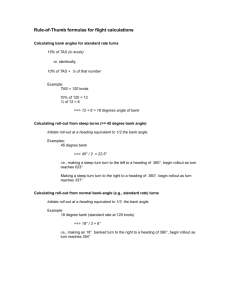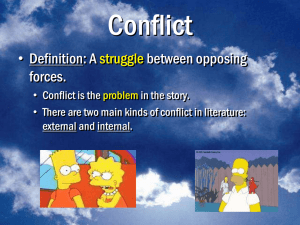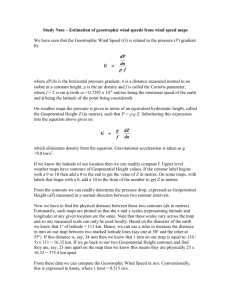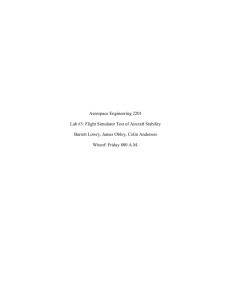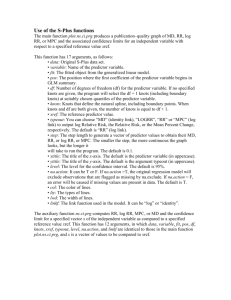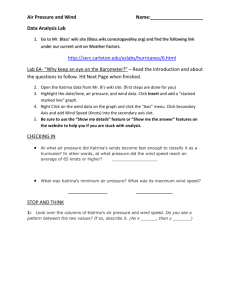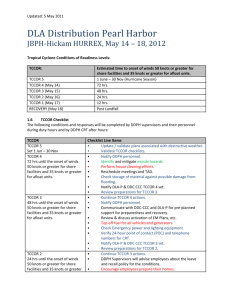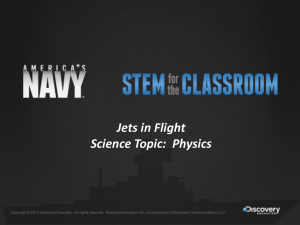Qual 2
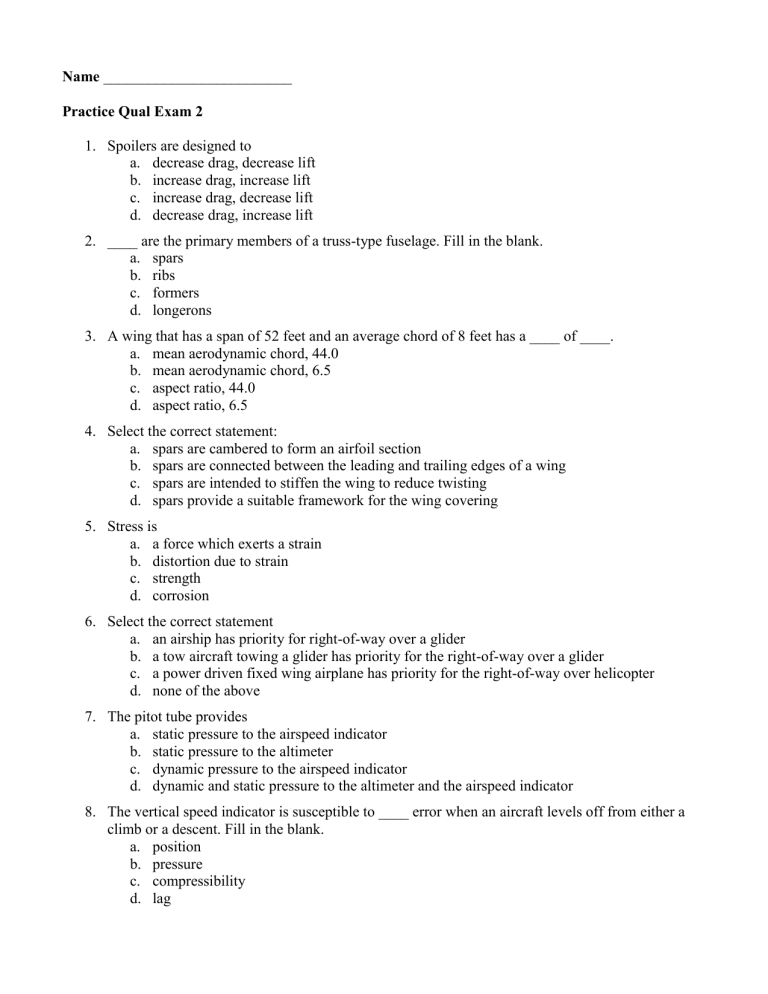
Name _________________________
Practice Qual Exam 2
1.
Spoilers are designed to a.
decrease drag, decrease lift b.
increase drag, increase lift c.
increase drag, decrease lift d.
decrease drag, increase lift
2.
____ are the primary members of a truss-type fuselage. Fill in the blank. a.
spars b.
ribs c.
formers d.
longerons
3.
A wing that has a span of 52 feet and an average chord of 8 feet has a ____ of ____. a.
mean aerodynamic chord, 44.0 b.
mean aerodynamic chord, 6.5 c.
aspect ratio, 44.0 d.
aspect ratio, 6.5
4.
Select the correct statement: a.
spars are cambered to form an airfoil section b.
spars are connected between the leading and trailing edges of a wing c.
spars are intended to stiffen the wing to reduce twisting d.
spars provide a suitable framework for the wing covering
5.
Stress is a.
a force which exerts a strain b.
distortion due to strain c.
strength d.
corrosion
6.
Select the correct statement a.
an airship has priority for right-of-way over a glider b.
a tow aircraft towing a glider has priority for the right-of-way over a glider c.
a power driven fixed wing airplane has priority for the right-of-way over helicopter d.
none of the above
7.
The pitot tube provides a.
static pressure to the airspeed indicator b.
static pressure to the altimeter c.
dynamic pressure to the airspeed indicator d.
dynamic and static pressure to the altimeter and the airspeed indicator
8.
The vertical speed indicator is susceptible to ____ error when an aircraft levels off from either a climb or a descent. Fill in the blank. a.
position b.
pressure c.
compressibility d.
lag
9.
What is read from the altimeter when the barometric scale is set to standard barometric pressure? a.
true altitude b.
flight level c.
pressure altitude d.
both b and c
10.
The turn needle of the turn and slip indicator shows a.
the rate and radius of turn b.
the amount of bank and the direction of turn c.
the direction and rate of turn d.
the amount of slip and skid
11.
Rate of change of temperature with height is called a.
convection rate b.
advection rate c.
lapse rate d.
inversion rate
12.
In an isothermal layer, the ____ remain(s) constant. Fill in the blank. a.
pressure b.
temperature c.
temperature and pressure d.
temperature and relative humidity
13.
____ movement of air warmed by the earth is called ____. Fill in the blanks. a.
horizontal, deflection b.
vertical, advection c.
horizontal, convection d.
vertical, convection
14.
The neutral region between two high pressure and two low pressure areas is called a.
a trough b.
a ridge c.
a trowal d.
a col
15.
When an air mass is ____ and no new water vapour is added, the relative humidity will ____. a.
heated, increase b.
cooled, increase c.
cooled, decrease d.
both a and c
16.
An air mass may be defined as a large section of the ____ with uniform properties of ____ and
____ in the horizontal. Fill in the blanks. a.
stratosphere, temperature, pressure b.
troposphere, stability, pressure c.
atmosphere, stability, moisture d.
troposphere, temperature, moisture
17.
When air subsides, it a.
compresses and warms b.
expands and cools c.
expands and warms d.
remains constant in temperature and density
18.
A front is a.
a narrow transition zone between a cyclone and an anti-cyclone b.
a squall line c.
a narrow transition between two air masses d.
a wide area of layer cloud
19.
The normal time interval between METARs is a.
30 minutes b.
1 hour c.
3 hours d.
6 hours
20.
The normal time interval between TAFs is a.
30 minutes b.
1 hour c.
3 hours d.
6 hours
21.
The normal time interval between FAs is a.
30 minutes b.
1 hour c.
3 hours d.
6 hours
22.
Height of the cloud base can be determined from a.
surface temperature b.
the dew point temperature c.
the lapse rate d.
all of the above
23.
As altitude increases, the wind will normally a.
veer, then back b.
back, then veer c.
veer and increase d.
back and decrease
24.
Given: Heading = 123° (compass), Deviation = 3°E, Variation = 10°W. The true heading is: a.
130° b.
136° c.
126° d.
116°
25.
Pilotage refers to: a.
navigation by use of items such as predetermined wind vectors and TAS b.
navigation by reference only to landmarks c.
navigation by use of radio aids d.
none of the above
26.
Given: Track = 343°T, Heading = 353°T, Deviation = 3°E, Variation = 8°E.
Then the magnetic heading will be: a.
001° b.
335° c.
345° d.
348°
27.
Given: Start point = 45°N, 110°W, End point = 47°N, 110°W
Variation = 10°E, Deviation = 3°W
The track, heading, and distance are: a.
360°T, 007°T, 120 nm b.
353°M, unknown, 60 nm c.
350°M, unknown, 120 nm d.
007°T, 010°M, 120 nm
28.
66 nautical miles = ____ statute miles = ____ kilometers. Fill in the blanks. a.
76, 132 b.
86, 132 c.
76, 122 d.
86, 122
29.
An urgency signal is preceded by the word ____ and is repeated ____. Fill in the blanks. a.
PAN, 3 times b.
MAYDAY, continuously for 10 seconds c.
SECURITY, 3 times d.
DISTRESS, continuously for 10 seconds
30.
The word ____ means: “Okay, I have received your message”. Fill in the blank. a.
Roger b.
Confirmed c.
Affirmed d.
Acknowledged
31.
In Radiotelephone procedures, 12 o’clock midday, 12 o’clock midnight are expressed, respectively, as follows a.
12 AM, 12 PM b.
1200 AM, 1200 PM c.
1200, 2400 d.
1200, 0000
32.
Angle of attack is defined as the angle between the chord line and the ____. Fill in the blank. a.
true horizon b.
longitudinal axis c.
relative airflow d.
horizontal axis
33.
Longitudinal stability is a.
pitch stability b.
roll stability c.
stability around the lateral axis d.
both a and c
34.
Longitudinal stability is influenced by a.
the size of the horizontal stabilizer b.
dihedral c.
sweepback d.
keel effect
35.
Movement of an airplane about the normal axis is called a.
rolling b.
pitching c.
yawing d.
none of the above
36.
An airplane which is stable by design may become ____ unstable due to changes to the ____. a.
laterally, centre of pressure b.
longitudinally, centre of gravity c.
directionally, distribution of weight d.
directionally, centre of gravity
37.
Air flowing over the upper surface of a wing tends to flow: a.
inwards b.
faster than air flowing over the lower surface of the wing c.
neither a nor b d.
both a and b
38.
A stall occurs when there is no longer sufficient ____ to counteract the ____ of the airplane. a.
lift, drag b.
lift, weight c.
thrust, drag d.
thrust, weight
39.
Select the correct statement: a.
an aircraft accelerating in a climb is in equilibrium b.
an aircraft in straight and level flight at a constant airspeed is in equilibrium c.
an aircraft, which is turning at a constant altitude and constant airspeed, is in equilibrium d.
an aircraft accelerating in straight and level flight is in equilibrium
40.
Lift acts at 90 degrees to a.
the chord line of an airfoil b.
the lateral axis of an aircraft c.
the relative airflow d.
the angle of incidence
41.
Dihedral is a.
the angle which each wing makes with the horizontal b.
the difference between the angle of attack and the angle of incidence c.
the angle between the lateral axis and the sweepback d.
none of the above
42.
relative airflow is a.
parallel to the flight path of an aircraft b.
parallel to the horizon c.
opposite to the flight path of an aircraft d.
both a and c
43.
The position an airfoil where the boundary layer changes from laminar to turbulent flow is called a.
the separation point b.
the transition point c.
the delamination point d.
the reference point
GLIDER CANDIDATES CAN STOP HERE
44.
The advantage(s) of a wet sump lubrication system is/are: a.
light weight b.
good sump capacity c.
simplicity d.
both a and c
45.
The propeller: a.
moves a large mass of air backward at a relatively low speed b.
moves a small mass of air backward at a relatively high speed c.
converts torque to thrust d.
both a and c
46.
Viscosity refers to a.
resistance to deterioration b.
resistance to ignition c.
resistance to vaporization d.
resistance to flow
47.
EGT varies primarily as a function of a.
throttle angle b.
outside air temperature c.
fuel/air mixture d.
octane rating of fuel
48.
Given: Track = 260°T, Deviation = 8°E, Variation = 10°W, TAS = 120 knots,
Wind = 090°T at 30 knots
What is the resultant ground speed and compass heading to maintain track? a.
91 knots, 257° b.
145 knots, 262° c.
149 knots, 259° d.
152 knots, 257°
49.
Given: Track = 040°T, Variation = 12°E, Deviation = 4°W
TAS = 115 knots, Wind = 160°T at 25 knots
What is the resultant ground speed and compass heading to maintain track? a.
126 knots, 043° b.
105 knots, 055° c.
126 knots, 039° d.
105 knots, 039°
50.
Given: Track = 060°T, TAS = 110 knots, Wind = 150°T at 25 knots
The ground speed is ____ than the TAS. The wind correction angle is to the ____ of the track a.
less, left b.
less, right c.
same, right d.
more, right
